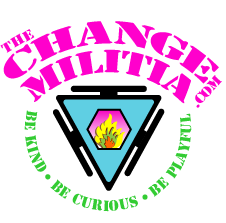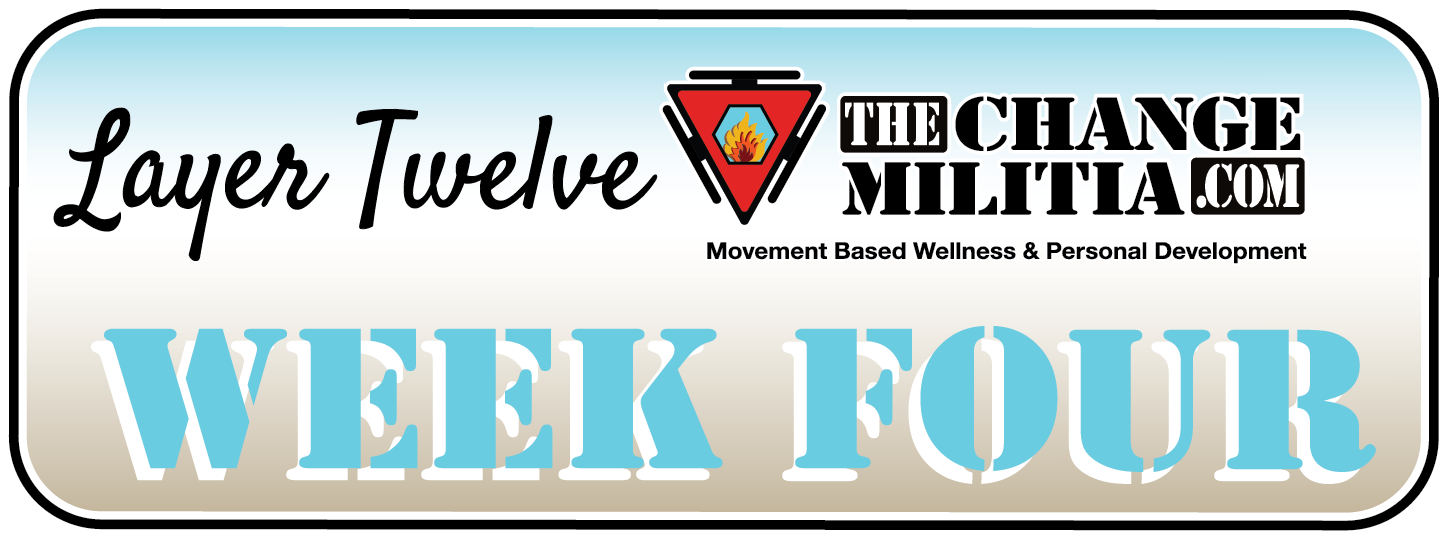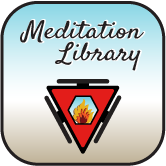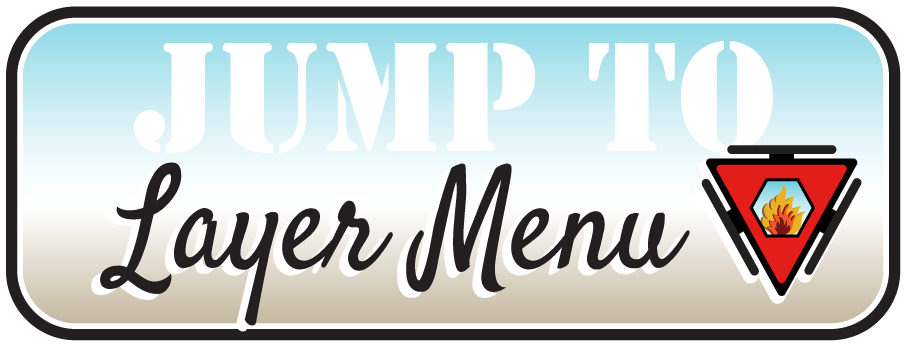Layer Twelve, Week Four – Sunday
- Review Layer Seven, Week Three Concepts
- Do one or all of these movements Current150 and Identifying Transitions.
Sunday Focus
Concentrate on your mental connection to others. When you first come into contact, what do you try to figure out? Pay attention to how much of your mental process is threat assessment and what that threat might be.
Concentrate on your emotional connection to others. Are your worried about what you are feeling or what they might be feeling? How do your emotional configurations change before, during, and after your interactions with others? As you interact with others, determine if your predisposition is for emotional or mental threat assessment.
Sunday’s Concepts
Time for the next few layers in your year-end review. If any of this doesn’t feel second nature to you, follow the links and review the concepts and accompanying movements. Take your time and hang out in the discomfort until your system adapts to the concepts and integrates the movements. You should continue to feel the intention and results of each movement. If not, do each until you do.
Your goal as you make your way through the review is to question your metabolization and digestion. Can you feel the ideas and movements in your body? Are you able to read without feeling confused, resistant, or oppositional?
If not, gift yourself some extra time, go back and feel deeper and fuller understandings. Build onto your strong foundation.
Layer Seven, Week Three – Concepts
First, a few quick definitions (directly from the Change Militia’s top-secret vault):
Compassion – The ability to imagine (mentally) what someone else might be experiencing and then generate an emotional response based up the value you assign to your projection of those experiences.
Empathy – The act of feeling what is felt by others or some aspect of the environment. Empathy also exists internally. You can have empathy for yourself.
A child’s experience of fear is much different than an adult’s. I have compassion when I understand the child’s fear. I have empathy when I can feel and experience what the child is feeling, the actuality of his or her experience.
Compassion creates distance. I separate myself from the child to concoct and project my understanding of their situation. When I imagine their situation, I am no longer present … I am off somewhere imagining. When I feel compassion, I am connecting to a story I have concocted.
When I am empathetic, I create intimacy. The child and I will share a common feeling. Empathy promotes resonance and harmony. We will experience the same energy configurations. We will bond because we are connecting with all of our bodies. Compassion only connects with the mental body. Any emotions felt from compassion are not connected to the other person, they are connected to the mental projection.
Every thought, emotion, and sensation you have is energy changing from one configuration to another.
Being empathic will allow you to gain mastery over your body, mind, and emotions. Once you have mastered your own configurations, you will be able to identify and understand what drives the actions and reactions of those around you without judgment, censure, or collusion. You will gain tolerance and compassion.
Most importantly, you will gain the ability to communicate with the held fears and limiting beliefs that influence so much of how you and others interact. Once you learn to communicate directly with other people’s fears, you can collaborate by aligning your energy configurations in a way that acknowledges and conveys acceptance.
Your path toward being an empath will start with identifying your energy configurations in each of your bodies and components. Once you have a baseline, you will begin to track your actions and reactions as you feel the influence other people and your environment have on you. After you can track the transitions, what, when, how, and why you act and react the way you do, you can begin to devalue the underlying images, patterns, and limiting beliefs. Once they are devalued, you will be able to choose your actions instead of being enslaved to your reactions.
You will go through the same process of identify, establish a baseline, track, devalue, and choose with the energy configurations of your significant other, family, friends, and co-workers. Your understanding of those people will blossom when you feel their energy configurations instead of just mentally judging or emotionally reacting.
As you identify, establish a baseline, track, devalue, and choose new actions; the people and things around you will begin acting and reacting very differently. You have thousands of spoken and unspoken, conscious and unconscious, agreements with everyone in your life. When you alter the pattern, you will be giving them an opportunity to alter their patterns.
Each of your bodies has a place of optimal balance. Each of those places has an energy configuration. As you are able to discern your balance points and the accompanying configurations, you can identify what is out of balance. Once identified, you can choose to alter your energy to match the most beneficial configuration. Once you are able to identify your optimal energy configurations, you will be able to assist others in achieving theirs. You will emanate your configurations in a way that promotes collaboration, metabolization, and the generation of momentum toward a mutually beneficial trajectory.
Here is the other big-picture aspect of empathy. When you have empathy for yourself, you no longer give value to what others think or say. When you are less externally focused on what others think, you will have more energy and drive to achieve your objectives. The unhealthy reaction will become healthy action. You will be driven from a place of intention, trajectory, and collaboration.
Empathy leads to fearlessness, tolerance, and a kindness so vast it radiates and permeates everything and everyone around you.
Layer Twelve, Week Four – Monday
- Read and review Monday Concepts
- Movements: Current150 and seven videos on energy configurations including: Stagnant, Fluctuating, Isometric, Expansive, Bleeding, Explosive, and Isotonic. Review any that you can’t explain with simple examples.
Monday’s Focus
Track your energy and find things in situations, relationships, or patterns that feel stagnant. What feels sluggish, heavy, spent, or weak? Where does it feel you are going in multiple directions at once? Where are you undecided?
Identify situations when you feel your energy configuration to be expansive. What are the constant or habitual drains on your system? What distractions occur regularly?
Monday’s Concepts
Layer Seven, Week Four Concepts
In every moment, every aspect of your body is in a state of transition. Every component that keeps you centered and balanced is being influenced by internal and external forces (energy configurations).
Layer Two, Week Two had a list of energy configurations as the gross indicators of your degree of receptivity, opposition, and resistance. Review, if necessary.
Your awareness of the energy configurations in each of your bodies and each of the components will help you identify your imbalances, your balanced points, and most importantly, the transitions between the two. Energy configurations lead to change. The scattered energy configuration is a well-spring of distraction.
Distracted is an unbalanced state. Let’s take an example: At 10:00 a.m., you are distracted by what to have for lunch or what to wear at a party. The distraction reduces your ability to stay centered on your intentions.
A solution to help you refocus and get back on track is to explore each of your bodies and see where the primary imbalance exists. The imbalance will exist when your bodies are not equally energized, your components are unequal, and/or your energy configurations in any of the bodies or components are not optimal.
For this example, it might be your emotional body. You are worried about something in the near future (lunch). Worry is a state of emotional imbalance. After you identify which body is the culprit, you can check the balance in each of the components of that body.
In the lunch example, you might be excessively focused on the emotional attachment to food (the fear of starving or not having/being enough). You might be placing too much energy on rejuvenation (the fear of weakness or death). You will probably lack emotional stability, flexibility, strength, and endurance in that moment.
Focus and Rejuvenation are overvalued and over-energized by your emotional body (and subconscious mind) and the other components are undervalued and weak. In the worried about lunch scenario, the components of your emotional body that are most imbalanced are focus and rejuvenation. The energy configuration (of your emotional focus) is scattered. The configuration of your emotional rejuvenation is compressive.
Scattered and compressive pull energy away from your intention and create distraction. Your emotional focus scatters because your focus is in a frenzy and drawn in multiple directions (mental stories, food choices, starving). Your emotional rejuvenation is compressive because it is only acknowledging one possibility, lunch, and trying to constrict and condense all your energy into only that.
Let’s explore why you began to worry about lunch. Worry happens because your subconscious mind doesn’t have anything to do. If you are comfortable and safe, your subconscious mind doesn’t have any threats to assess. Your subconscious mind wants to worry. It wants to monitor the momentary possibility that something it fears is going to happen and bring about pain, suffering, or death. When there are no fears present, it starts looking elsewhere.
The primary place it looks is your list of habits. Your subconscious mind classifies your fears by how you react to them not necessarily how dangerous they are. Think about when your parents, partner, or child want to trigger you. What do they do? They do what has worked before and what works the quickest.
If your subconscious mind knows that you habitually suffer from FOML (fear of missing lunch), it will plant a seed that you should check Yelp, Instagram, and Pinterest for lunch ideas. Your conscious mind may initially ignore that seed… so your subconscious mind starts adding energy to the fear. The added energy creates a sense of urgency (momentum) until you either, get distracted, or refocus your determination (re-center and rebalance). Refocusing your determination is the conscious choice to change your energy configuration(s).
Layer Twelve, Week Four – Tuesday
- Read Tuesday Concepts
- Movements: Current150 and seven videos on energy configurations including: Compressive, Transitive, Fluid, Percolating, Scattered, Accumulating, and Centering. Pick one or more that feel foreign.
Tuesday’s Focus
Where are you stubborn or inflexible? What in your life feels like it is in some sort of transition? How aware can you be of your changing energy configurations and the changes happening in your environment?
Where and when do you have the least resistance? What’s bubbling up for you? What held energy, thought, or emotion feels like it is starting to move? How do you rejuvenate and what does it feel like?
Tuesday’s Concepts
Layer Eight, Week One Concepts
To be empathetic is to respond synergistically to moving energy.
The opportunity you have is to get to know your energy configurations so that you can feel the contrasts, stark and subtle, between you, others, and your environment. As you become aware and then acknowledge your own energetic resistances, you will feel how you limit your capacity to be kind, loving, successful, fulfilled, happy, and intimate. You will feel how energetic configurations limit your expression, lead to reaction, and can stifle your ability to act.
When your discernment increases, your awareness increases. Elevated awareness cultivates depth in your connections. As you deepen your connections, opportunities will be more perceptible. As you act on your increased opportunities, everything will feel effortless.
Understanding energy configurations and then cultivating fluidity will add incalculable value to your life, to the lives of your loved ones, friends, family, neighbors, and associates. Your fluidity will be water to a thirsty garden. Empathy stimulates collaboration, collaboration engenders intimacy, and intimacy awakens deep, meaningful connections.
The Current150 you have been doing will begin the process of understanding, feeling, and encouraging empathy. It will start when you identify the energy present in each of your bodies. As you get better at identifying the configurations present, you will feel how your bodies usually configure differently. That difference might be subtle or drastic. The imbalances may conflict or collude. One body may be moving toward centered fluidity and another away.
Centering and balancing your bodies will be a practice. Being centered and balanced will be a juggling act. Physically, if my energy is low, I can do something to increase it. Something as simple as rest, singing, or a quick walk around the block.
Emotional balance can improve with meditation, rest, or some personal interaction. If I am emotionally scattered, meditation and conversation will be centering. When I am scattered and accumulating, conversation will bring my emotional energy into focus and give it some place to go.
Mentally, increasing the blood flow and oxygen to my brain usually helps. That means physical movements, breathing exercises, or vocalizations. I will look to find something that will create momentum that my mind can entrain with.
To soothe and balance the energy in my subtle body, I will do some physically fluid movements or a Kriya (energy rotation). Every movement from all the weeks in Layer Three are Kriyas. Other movements would be things like Tai Chi, Taoist Yoga asanas, rhythmic full-body dancing, or any martial-arts forms or katas.
Rejuvenating my environmental body would be as simple as being social with someone or people that I resonate with. Calling a friend or family member, being socially effusive with people I meet on the trails, or going for a mountain bike ride with a friend. And it doesn’t require people. Hug a tree, pet a dog, dig in the dirt, feel the texture of rocks; anything that allows you to connect your inner body to the outer world in a loving and curious way.
When I take each of my bodies individually, it becomes a pretty simple and quick task. I don’t let myself bog down in any stories, blame, recriminations, history, or projections. I gauge my actuality. I look at myself in the moment and begin the process of finding optimum by getting balanced and centered. I respond to my imbalance by making a series of decisions that will move me toward my current best.
You will take that model and apply it to yourself, your family, relationship, and career. You can use it for your goals, trajectories, and to maintain the integrity of your highest aspirations.
Empathy will give you the ability to influence your body and your environment in increasingly beneficial ways. Empathy will give you a fuller understanding of what is holding you back, what is holding others back, and the tools to remove those impediments.
Empathy is the path from potential to opportunity. You will beneficially influence others by being accepting and offering options that they don’t initially perceive. As you accept yourself and learn to accept others, defenses will lower, collaboration will increase, and playful, effortless success will ensue. Empathy is how you will change the world from the inside out.
Layer Twelve, Week Four – Wednesday
- Read Wednesday Concepts
- Do one or both movements: Instant Assessment and 5 Minute Healing Meditation
Wednesday’s Focus
As you move through the week, feel for basic energy flows. Try to identify initial energy movements and then the transitions as they happen. Feel the energy flows in each of your bodies and relate it to optimal. Monitor your resistances.
Spend the day assessing the areas of your life where your mind, thoughts, images, and beliefs bully your other bodies. Where are you physically, emotionally, and environmentally reactive? Where does your mind convince you what to feel? Where does your mind limit your physical, emotional, and relational expression of your SuperHeroSelf?
Wednesday’s Concepts
Layer Eight, Week Two Concepts
You have explored some general energy configurations. As a reminder, the configurations were fluid, accumulating, centering, percolating, expansive, scattered, explosive, stagnant, isotonic, isometric, fluctuating, bleeding, compressive, and transitional. Fourteen energy configurations are a lot to remember. The purpose was to help acquaint you with how energy moves, to give you a feeling of the differences and subtleties.
Moving energy may be innervating, neutral, or deflating. Innervating energies would be accumulating, expansive, fluid, percolating, and isotonic. Neutral energy configurations could be fluctuating, percolating, and isotonic if the outcome is neither beneficial or non-beneficial. The energies that deflate energies include scattered, explosive, stagnant, isometric, bleeding, and compressive. Fluctuating, percolating, and isotonic are deflating if they leave you with less energy.
As you assess the energy configurations in your bodies and components, feel for the degree of benefit. As you can feel and identify the energy configurations, transitions, and relationships, you will have the tools to gradually shift those energies to ones that are increasingly beneficial.
When you are centered, balanced, and being your most optimal self, it probably won’t feel like you think it will feel. It will be unfamiliar. There will be healthy discomfort. At optimal levels, your bodies will be humming with energy. Optimum is you being your SuperHeroSelf, not your comfortable and familiar self. Today, you would probably label SuperHeroSelf as stressed, overwhelmed, and unsafe.
The first step toward being your SuperHeroSelf will be to gauge the trajectory of your energy by doing the Instant Assessment movement for this week. The subjective assessments (charged, undercharged, overcharged) and (strongly agree, agree, disagree, strongly disagree) will be a starting point, a gross valuing of how you feel.
As your capacity grows, your labeling will change. What feels charged now will be undercharged in the future. It is relative. Today, balanced, centered, and optimal will be at different levels in each body. Achieving overall balance will require that you bring your non-dominant bodies up to the levels of your dominant bodies. Initially, you may have to lower the energy in your dominant body to find balance.
Your subconscious mind will not be happy with you. It wants to keep you the way you are. You will use your conscious mind to make decisions and take actions that lead you toward optimal balance and then consciously tolerate the healthy discomfort that accompanies growth.
Do you know which is your most dominant body and the least dominant? What are your hierarchical defaults? Most Americans are mentally dominant. We think, compare, and contrast. We are subjective. We see the world as good/bad, right/wrong, and want/don’t want.
Your mind is the referee, martyr, and the bully. It is important to acknowledge that. It is an extension of your subconscious mind. Your subconscious mind is trying to limit your expansion and uses your mental body as its enforcer.
You were taught to go through life thinking. It has become the social norm. What you will explore in the next few layers is what it feels like to go through life feeling.
Let’s look your non-dominant bodies. For most Americans, it will be your environmental body and here is why. When you are mentally dominant, you are in constant threat assessment mode. The threats you are assessing are in your environment. You are overtly aware of what is going on around you. When you worry, you usually worry about external situations, relationships, or interactions. When you are thinking, you are probably thinking about people, places, or things.
When your mental body and environmental bodies are dominant, it creates an imbalance. That imbalance is your current normal, so most of the time it will not seem like you are imbalanced. Your systems, bodies, and components have adapted to, habituated, to the imbalance. Your subconscious mind has decided your current imbalance is survivable and has made the imbalance its preference.
If you have a regular, consistent, healthy, and symmetrical physical practice, your physical body is probably balanced. A symmetrical practice would be one where you give equal time to each of the components. A long trail run emphasizes one of the components (endurance) but it doesn’t address the other components equally. If all I make time for is a trail run, I can encourage centered, optimal balance by rock hopping (focus), hill climbs (strength), log runs (stability), sprinting occasionally (speed), and then allow enough time to stretch and relax when I am done (flexibility and rejuvenation).
The most undervalued, fluctuating, and undercharged body of most Americans is the emotional. It is like having a crazy person in your closet. Quiet most of the time and then all Hell breaks loose.
If your emotional body is your dominant body, it will feel different. It will feel like the real you is in the closet and the crazy person is running loose. You are emotionally dominant if your feelings override your logical, conscious, mind. If you are irrational or irrationally emotional, your emotional body is in charge. Your emotions run the show if your primary reaction to most interactions is emotional.
When you are mentally and environmentally dominant, your emotional body becomes your reactive body. You think yourself into an emotional state that confirms your thoughts. Your thoughts regulate, govern, and control your emotional configurations. You react to your mental configurations by changing your emotional configurations.
If you feel a physical reaction to being reprimanded, repressed, or disparaged, you are allowing your physical body to be controlled by your thoughts. Being disparaged isn’t a physical threat. When you choose to physically react (get tense, flushed, or activated), you are subjugating your physical body to your thoughts. You are physically reactive.
If you can maintain your physical and emotional equanimity (balance) while your mind is panicking, it is a sign that your bodies function freely and independently. There is no collaboration without independence. There is no intimacy without freedom. That is true for your bodies as well as your components and every relationship you have.
Layer Twelve, Week Four – Thursday
- Read Thursday Concepts
- Do one or both movements: Body Assessment and Resistance, No Resistance
Thursday’s Focus
Spend the day being aware of physical energy entering or leaving your body. Begin to recognize the quality and impact physical energy has when it moves.
What triggers your held emotional energy to flow? Can you feel what incoming emotional energy feels like? Try to feel how your mind influences your physical body. See how many times you can feel your body tense, relax, or freeze after a thought crosses your mind.
Thursday’s Concepts
Layer Eight, Week Three Concepts
Let’s look at your energetic body and how it influences and is influenced by the other bodies, other people, and your environment.
Everything in your environment, including your body, mind, emotions, is energy. That energy is always moving. Consciousness inhabits energy. Your soul resides in your energy body. You become what you do, how you move, and where you change. You are the sum total of your transformations.
A rock is energy. Looking at the rock, you wouldn’t think of it as energy moving. During the heat of the day, a rock can absorb a lot of thermal energy from the sun. It stores it and releases it when the ambient temperature is lower than its temperature. Generally, the energy moves from the surface toward the middle during the day and from the middle out at night. The rock absorbs and distributes energy from and to the environment. The rock’s energy is influenced by its environment.
Your bodies work the same way as the rock. They absorb and distribute energy. Sometimes pressure changes them. Bones break and tissues rupture when there is more energy and pressure than they can absorb.
Your physical body absorbs air, water, food, heat, and light. After you absorb things, you digest, store, and discard. When you eat an apple, your digestive system breaks down the apple into its base elements and then absorbs what it can. What it can’t metabolize, it collects and eliminates.
The energy from the apple is converted to energy that is usable at the cellular level. The apple has an energy potential (caloric value) that is freed up and converted during digestion. When the energy from the apple is absorbed by, say, the muscles in your calf, it is then expended when the calf muscle contracts. Your other bodies absorb, store, and distribute energy too.
Memories are stored energy. You see, hear, feel, taste, smell, or experience something (absorption) and a part of that energy gets stored. When something happens that resonates with that stored energy, it gets released.
Riding a bike, bowling, or playing a video game when you haven’t in a while uses a ton of stored energy. Physically, your body recalls the movement sequences necessary, mentally, you remember pertinent details and judgments, and emotionally you remember your emotional connection. You reconfigure your energy to match the current situation.
Energy reconfiguration is the transition from one configuration to another. If you are deathly afraid of spiders or mice, recall their state of being before, during, and after an encounter. Before, you were doing what you were doing, being who you were being and then EEEEK!, you totally reconfigured your energy to focus on the threat. Wikipedia has a great overview of what happens in your body. Click on the link and scroll down to Reaction.
Fear always reconfigures your energy. Recall the last time you were startled, can you remember how it totally changed your bearing, attitude, and posture? The fight, flight, or freeze response is energy reconfiguring to meet a current threat, real or imagined. The energy that triggered the reaction was stored energy that resonated in some way with a current stimulus (perceived threat). Fear initially focuses your mind and body. If there is an actual threat, your focus will remain until fatigue sets in.
If the threat is imagined, your initial focus will be strong and then your mind will create and add new (imagined) threats since the initial threat is fictional (created by your subconscious mind). There is nothing actual for you to focus on … so your subconscious mind continues to create a plethora of fictitious threats until your energy moderates. Hysteria and panic are energy configurations brought on by fear triggers and compounding fictions.
Emotional energy coalesces. Your emotional body is a fluid field of energy that constantly reconfigures itself in response or reaction to stimuli. A Plasma Ball is a pretty good visual aid. Most, if not all, the emotions that you label and feel are brought on by your subconscious mind. It connects present stimuli to some past, present, or future reference and then judges those current stimuli hierarchically.
You are never any emotion until your subconscious mind configures and realigns your emotional body to that label.
Before the label, you existed without the label. There were energies present, stimuli and sensations, that you were feeling without judging, valuing, or qualifying them into some familiar box (label).
Layer Twelve, Week Four – Friday
- Read Friday Concepts
- Do one or more movement – Balancing Your Bodies and Releasing Resistance.
Friday’s Focus
Watch the linked Fractal video for at least 5 minutes with the accompanying soundtrack and feel for changes in your physical, mental, and emotional bodies. What thoughts, memories, labels, or judgments do the changing images and music bring up?
Mute the accompanying soundtrack and watch the fractal video with a favorite upbeat song playing in the background. Watch several minutes of the video again with a least favorite song playing in the background. How do your memories, labels, or judgments reconfigure differently?
Friday’s Concepts
Layer Eight, Week Four Concepts
Your energetic, emotional, and environmental bodies are in a constant state of flux. They group, regroup, and ungroup into and from electromagnetic fields of varying sizes, trajectories, and fluid compositions or expressions.
Energy flows to where your attention goes.
Understanding how energy flows and where it collects when you configure and reconfigure will help you feel changes sooner. Initially, you might feel them after they happen, then as they happen, and then as they are about to happen. When you get to the place where you can predict changes in your or other’s configurations, you can consciously choose to encourage or discourage your transitions.
When you are mentally unbalanced, your energy flows are also unbalanced. They reconfigure to encompass and encapsulate to keep you from permanently fragmenting. If you are obsessing about something in the future, your energy will be in front and above you. When you are actively remembering something, your energy is behind and above you. If you are emotionally obsessing about your relationship, your energy will be in your chest. If you are deeply worried about your body, your energy will center around your low belly. If you are trying to manipulate someone into doing something they don’t want to do, your energy will be projected into their energy field.
You will explore these much more in the weeks to come, but here are a few quick examples of energy configurations. Let’s say you are having a conversation with your ten-year-old. If you feel your energy wanting to scatter and diffuse, you will be forewarned that you are about to move into distraction and lose your ability to be present. As a healthy, involved, and empathetic parent, you can choose to refocus your energy on what your offspring is saying.
If you feel your energy compressing and beginning to reach toward your child, it will be a sign that you are getting angry. Compressing and scattering will be a sign of frustration. Shifting your energy to centered expansion will encourage your bodies and systems to be empathetic, understanding, and tolerant.
If you feel your energy pulling and shifting toward your back or behind you, it is a sign you are fearful and the degree of intimacy or connection is about to trigger a fear response that will lead to distancing and disconnection. Acknowledging your fear and dismissing it as a projection will help you regain a centered presence.
If you believe you are being loving but your energy is overwhelming your solar plexus, that will signal your love has an element of judgment and restraint. Your solar plexus is where you evaluate your safety in relationship. By encouraging energy to increase and flow from your low belly to your heart, you will reconfigure your energy toward love without demand.
If you feel your energy actively pushing your child, you will know you triggered and trying to create distance. Recognizing your fear and judgment, you can acknowledge that you are safe, soften your energy, and allow it to re-center and then expand.
If you feel your energy trying to pull your child, you will know you are trying to manipulate and mold your child into something that you will be more comfortable with. Pulling energy signals non-acceptance, intolerance, and disregard. As you relax your desire to pull, you will be able to accept your child’s individuality and path and then be in a position to look at the situation from multiple sides and multiple time frames.
As you find yourself in energetically charged situations, see if you can discern where your energy is collecting or pooling. Feel for whether it is compressing, expanding, diffusing, or fragmenting. Feel for the direction it is moving and the level of resistance.
The energy in all your bodies will react and respond to the value your conscious and subconscious mind places on current potential and opportunity. Your energy responds or reacts to the value you assign and then your bodies reconfigure to confirm that assigned value. When you believe you are threatened, all your bodies react to that threat. When you believe that you are sad, your bodies reconfigure to confirm that label. When you feel happy, your mind and physical body respond and then reconfigure to align with that feeling.
The bodies interact and inter-react. Subconscious inter-reaction creates patterns that lead to distraction, diffusion, and dysfunction. Conscious interactions between the bodies lead to success, fulfillment, playfulness, and fluid efficiency.
Layer Twelve, Week Four – Saturday
- Read Saturday Concepts
- Do one or both movements: Balancing Your Bodies and Releasing Resistance
Saturday’s Focus
Do a Current150 right when you wake up in the morning. Do another after you have completed your morning rituals, drive from one place to another, after arriving. Feel for the changes in sensation. Where do your tension levels rise and in what bodies?
Do a Current150 before and after doing the Balancing Your Bodies Kriya. Identify your imbalances and then track the effectiveness of the Kriya. Where did the Kriya succeed in balancing your bodies and where did it fall short? Track and encourage the transitions from imbalance to balance in each of your bodies.
Saturday’s Concepts
When you allow your energy body to expand fluidly, you prime the other bodies for growth and adaptation. Energetic expansion encourages beneficial mental, emotional, physical, and environmental development and evolution.
The value your bodies place on any given situation or stimuli is rarely the same. Your physical and emotional bodies are going to value hunger differently than your mental and environmental bodies. Conversations with coworkers will be prioritized much higher by your mental and environmental bodies than by your physical and emotional bodies.
Imbalances happen because the subconscious value your bodies place on things is different.
Understanding and being able to feel energy configuration variables will help you predict where things are heading and understand more fully where they’ve come from. It will also help you connect with things easier.
The sensing mechanisms of each body seek and evaluate or detect and react. Seeking only happens when there isn’t a current threat being addressed. If your system is always in threat detection, there is rarely any time or energy for you to assess opportunities.
Value is assigned hierarchically in three tiers. The first tier is threat, second is familiarity, and the third is benefit. Your mind, especially your subconscious mind, values what is beneficial last. Think about hunger and satiation. Can you feel the different value you give to each? You are programmed to value hunger more strongly than being full. Some of it is physiological but most are mental and emotional.
Your mental body detects threats by comparing the internal and external stimuli of the moment to historical and projected data. You see, feel, smell, taste, hear, or sense something and your mind starts associating it with your database of knowledge and experience … and projections.
Your emotional body detects threats by compounding sensations into a matrix (label) that it compares with your existing list of bad or negative emotions. When it finds a match, it uses the majority of its energy to completely fully reconfigure itself to the chosen label and then tries to convince your other bodies to follow suit.
Your physical body is the least reactive. It spends the majority of its energy in movement and the processing of energy for fuel. When it reacts, it shifts its energy to address the perceived threat.
Your environmental body is in near constant threat assessment. It tries to pull energy from your mental and emotional bodies by prioritizing external stimuli over internal.
Your energy body is the most reactive. It reacts every time any of the bodies reconfigures. Every reconfiguration is assessed as a possible threat. The main reason it is so hard to stay balanced is because your energy body is so reactive.
When your bodies aren’t in threat assessment, the second tier, familiarity, comes into play. Familiarity is when each body decides whether or not it is in a familiar range and a safe configuration (comfort zone). Your bodies evaluate how close they are to the edge and what they can do to return to the middle of their respective ranges.
Mentally, your subconscious mind looks for the degree to which your thoughts, emotions, and physical expenditures are in line with your limiting beliefs and patterns. Put simply, if your subconscious mind doesn’t detect a threat, it then looks to see if you are in your comfort zone.
If your emotional body doesn’t have sufficient stimuli to create bad or negative labels, it looks for familiar labels. It tries to decide how current stimuli conform to your historical labels. Your emotional body tries to get you to feel some way you have felt before and then act and feel in a way that is recognizable. This is what makes up the majority of your personality.
Physically, your body looks for comfort when it is not tensing in reaction to some mental or emotional impulse. Its priority becomes relaxation and rejuvenation. Tension in your physical body is a sign of poor communication with itself and the other bodies.
Your environmental body looks for familiarity when no current threats are detected as a way to gauge and reduce future threat potential. It looks to confirm that all current relationships are in a recognizable and previously experienced configuration. Once confirmed, your environmental body tries to convince you to maintain those existing, known, and survivable patterns.
The comfort zones of each of your bodies may or may not be healthy, efficient, and productive. They may or may not be playful, happy, or fulfilling. But they will always be familiar.
When your bodies aren’t being threatened and are firmly entrenched in their familiar zone, then and only then will they start looking at the third tier, benefit. When you feel safe and comfortable, your bodies start looking for opportunities.
After your mental body relaxes into its comfort zone it starts to expand. It expands because it isn’t spending a ton of energy dealing with threats or getting you back to your comfort zone. Since the energy it is creating has no place to go, it starts looking for places, opportunities, to use it, to expand into. Creativity happens from this place. Deep understandings happen when your mind seizes opportunities to grow beyond the familiar.
Your emotional body expands beyond its familiar range when emotional energy builds without a habitual outlet. Your physical body expands into current opportunities when your rejuvenation leads to vibrant and vivacious vitality. Your environmental or relational body starts looking for ways to spend some of its burgeoning energy on expansion. It starts looking to increase its influence by the cooperative comingling of collaborative connections.
When you can get to the place where you allow your energy body to expand fluidly, you prime the other bodies for growth and adaptation. Energetic expansion encourages beneficial mental, emotional, physical, and environmental development. When all your bodies are vibrant and in sync, a fluid fusion happens. The bodies begin to collaborate and cooperate. They get more conscious, less reactive, and more responsive. They work together to identify and playfully seize opportunities.

















